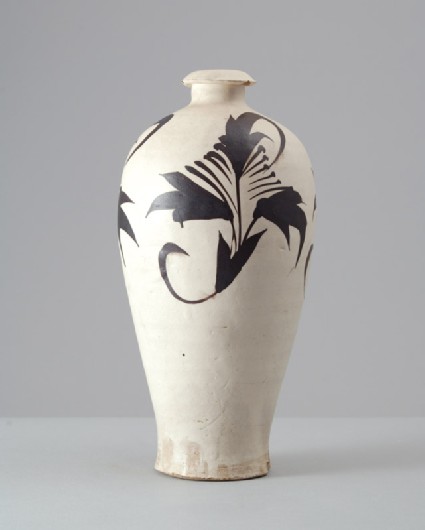The Barlow Collection
A select catalogue of the Barlow collection of Chinese Ceramics, Bronzes and Jades by the University of Sussex (published Sussex, 2006).

Publications online: 456 objects
Cizhou ware vase with floral decoration
- on display
- loan
-
Literature notes
This form, known in Chinese as meiping (‘prunus blossom bottle’), was one of the most characteristic Chinese shapes since the Song dynasty (AD 960–1279). Examples were produced by most Chinese kilns and remain popular until today. Compare also a jar with a similar design in the Barlow Collection [LI1301.330].
The piece is well potted, of slender form, tapering from the rounded shoulders towards the base, where it is slightly flared, and terminating in a low, narrow neck with an everted sloping rim. The base is recessed and has a high footring. The yellowish-beige stoneware bears a white slip, applied in two layers, and is painted with three brown foliate sprays under a transparent glaze. The different layers of slip and glaze are ending unevenly above the base, leaving footring and base in the biscuit. -
Details
- Associated place
-
Asia › China › Cizhou kiln-sites (place of creation)
- Date
-
12th - 13th century (1101 - 1300)
Jin Dynasty (1115 - 1234)
- Material and technique
- stoneware, thrown, covered in white slip, and with brown slip-painted decoration under a transparent glaze; unglazed base; glazed rim
- Dimensions
-
24.7 cm (height)
12.5 cm (diameter)
at foot 7.2 cm (diameter)
- Material index
- Technique index
- Object type index
- No. of items
- 1
- Credit line
- Lent by the Sir Alan Barlow Collection Trust.
- Accession no.
- LI1301.189
-
Further reading
University of Sussex, and Arts and Humanities Research Council, The Barlow Collection, supervised by Regina Krahl, Maurice Howard, and Aiden Leeves (Sussex: University of Sussex, 2006), no. C179a
Glossary (3)
glaze, slip, stoneware
-
glaze
Vitreous coating applied to the surface of a ceramic to make it impermeable or for decorative effect.
-
slip
A semi-fluid clay applied to a ceramic before glazing either to coat the surface or for decorative effect.
-
stoneware
Ceramic material made of clay which is fired to a temperature of c.1200-1300⁰c and is often buff or grey in colour.
Location
Objects are sometimes moved to a different location. Our object location data is usually updated on a monthly basis. Contact the Jameel Study Centre if you are planning to visit the museum to see a particular object on display, or would like to arrange an appointment to see an object in our reserve collections.
Galleries
Publications online
-

The Barlow Collection
This form, known in Chinese as meiping (‘prunus blossom bottle’), was one of the most characteristic Chinese shapes since the Song dynasty (AD 960–1279). Examples were produced by most Chinese kilns and remain popular until today. Compare also a jar with a similar design in the Barlow Collection [LI1301.330].
The piece is well potted, of slender form, tapering from the rounded shoulders towards the base, where it is slightly flared, and terminating in a low, narrow neck with an everted sloping rim. The base is recessed and has a high footring. The yellowish-beige stoneware bears a white slip, applied in two layers, and is painted with three brown foliate sprays under a transparent glaze. The different layers of slip and glaze are ending unevenly above the base, leaving footring and base in the biscuit.
Notice
Object information may not accurately reflect the actual contents of the original publication, since our online objects contain current information held in our collections database. Click on 'buy this publication' to purchase printed versions of our online publications, where available, or contact the Jameel Study Centre to arrange access to books on our collections that are now out of print.
© 2013 University of Oxford - Ashmolean Museum





